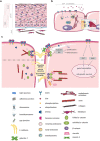Interplay between EGFR, E-cadherin, and PTP1B in epidermal homeostasis
- PMID: 35875939
- PMCID: PMC10364651
- DOI: 10.1080/21688370.2022.2104085
Interplay between EGFR, E-cadherin, and PTP1B in epidermal homeostasis
Abstract
Maintaining epithelial homeostasis is crucial to allow embryo development but also the protective barrier which is ensured by the epidermis. This homeostasis is regulated through the expression of several molecules among which EGFR and E-cadherin which are of major importance. Indeed, defects in the regulation of these proteins lead to abnormalities in cell adhesion, proliferation, differentiation, and migration. Hence, regulation of these two proteins is of the utmost importance as they are involved in numerous skin pathologies and cancers. In the last decades it has been described several pathways of regulation of these two proteins and notably several mechanisms of cross-regulation between these partners. In this review, we aimed to describe the current understanding of the regulation of EGFR and interactions between EGFR and E-cadherin and, in particular, the implication of these cross-regulations in epithelium homeostasis. We pay particular attention to PTP1B, a phosphatase involved in the regulation of EGFR.
Keywords: E-cadherin; EGFR; Epithelium; PTP1B; differentiation.
Conflict of interest statement
No potential conflict of interest was reported by the author(s).
Figures

References
Publication types
MeSH terms
Substances
LinkOut - more resources
Full Text Sources
Research Materials
Miscellaneous
